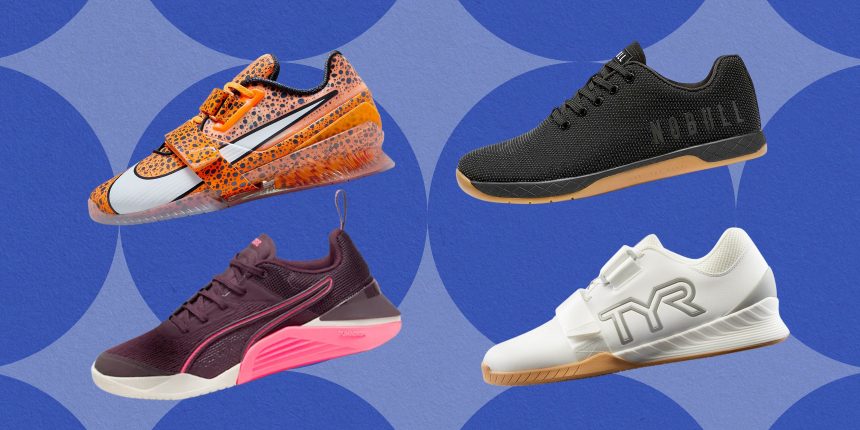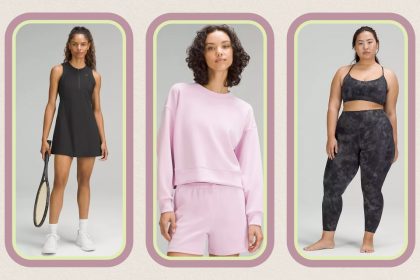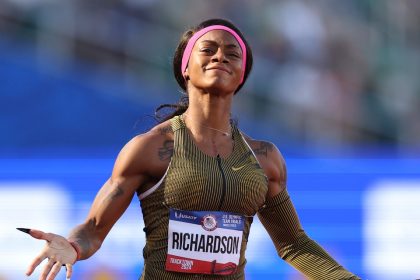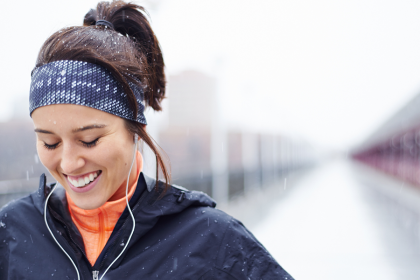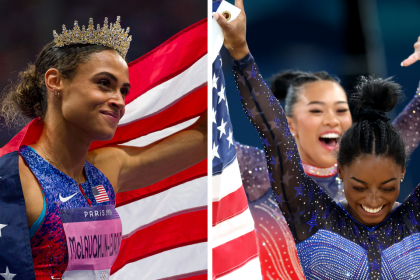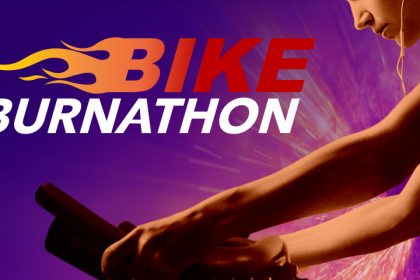All products are independently selected by our editors. If you buy something, we may earn an affiliate commission.
Good footwear keeps you comfortable when you’re strength training, but the best weightlifting shoes can actually improve your form and keep you safe while you work out. Just like running shoes, weightlifting shoes have specialized features (like a stiff, sturdy base and a snug fit) to help you maintain proper body alignment during your exercises. Ultimately, they can help you feel more grounded and confident while you train.
We spoke to personal trainers and foot health experts to get more info on how to pick the pair that’s right for you. Then we tested some of the most popular weightlifting shoes to see if they really live up to the hype. Our favorites are firm, stable, and supportive, so you can focus on your reps (not your steps).
Our top picks
- Best Overall, Flat: Puma Fuse 3.0
- Best Overall, Lifted: Adidas Powerlift 5 Weightlifting Shoes
- Runner-Up: Nobull Black Gum Trainer
- Best Budget: Converse All Star ’70s High Top Sneakers
- Most Comfortable: Lululemon Strongfeel Training Shoe
- Best for Stability: Reebok Nano X4
- Best Squat Shoes: Core Weightlifting Shoes
- Best Cross-Trainers: Nike Metcon 9
FAQs about weightlifting shoes
What are the benefits of weightlifting-specific shoes?
Footwear made specifically for strength training is a worthy purchase for any dedicated gym-goer. That’s because weightlifting shoes are designed to be stable and supportive, so you can firmly plant your feet and generate the power you need to move heavy weights, Jared Gremillion, DPM, a podiatric surgeon at Holston Medical Group in Bristol, Tennessee, tells SELF.
Weightlifting shoes are different from many running shoes, which often have a curved rocker sole. Those bottoms are designed for forward movement, which can throw off your balance while lifting. In other words, it’s not a great idea to wear running sneakers when you’ll be focusing on strength training—instead, opt for one of the flatter pairs below.
Are shoes necessary for weightlifting?
While it’s not uncommon to see someone doing squats and deadlifts in their bare feet, Dr. Gremillion advises against it. “It’s such an individual thing,” he says. “[But going shoeless] is not recommended by any means. No surgeon would ever recommend that.” This is because, while barefoot lifting may help you feel more connected to the ground, it also puts you at greater risk of injury; if you lift heavy, the excess load on the muscles and bones in your feet could increase your risk for stress fractures—or you could drop a weight on your unprotected toes (ouch).
Your feet need some amount of structure in order to be a good foundation when you’re lifting, Janine Hatch, PT, DPT, a physical therapist with the Hartford Healthcare Rehabilitation Network in Connecticut, tells SELF. Without it, you can develop plantar fasciitis (which is characterized by stabbing heel pain) from the extra load that weightlifting puts on your feet, she explains, adding that your whole lower half is at risk of straining when you skip proper footwear. “Wearing a supportive sneaker helps maintain the integrity of the midfoot posture and supporting ligaments in your feet, knees, and hips,” Dr. Hatch says.
What should you look for in a weightlifting shoe?
Stability is key: Shoes made from sturdy materials with a stiff, wide sole will help you feel grounded while strength training, Dr. Gremillion says.
On that note, you don’t want a ton of cushioning underfoot, because too much padding can throw off your form and balance, Tiffany Thompson, an NASM-certified personal trainer and Future app trainer, tells SELF. We love a good, foam-laden sneaker (and your shoe can have some cushioning if you plan to use it for cross-training), but a harder sole is the better choice for when you’re lifting.
When it comes to heel drop—or the difference in height between the heel and midfoot—it’s dealer’s choice. The best heel height for you really comes down to personal preference, Dr. Gremillion says. A flat shoe enables you to push through your heels, helping you move weights up with more force, which is useful for exercises like deadlifts. On the other hand, an elevated heel increases your ankle’s range of motion, which can help you maintain your posture and get deeper into certain lifts, like back squats, Thompson explains.
Dr. Gremillion adds that shoes with raised heels may be useful if you’re working on improving your form, as they can help keep your spine straight and your abs engaged. Most pairs are between 18 and 20 millimeters tall under the heel, although you can find lower and higher options (trying on a few different pairs can help you find your preferred height).
If you like a snug fit, consider a pair that has both traditional laces and an adjustable midsole strap—that combination should keep your feet from shifting mid-rep. Have sweaty feet? Look for a shoe with mesh panels and perforations, which allow for better breathability without sacrificing structure. Ultimately, the shoe you choose should make you feel comfortable and confident, and not distract you from your lifts, Dr. Gremillion says.
We’ve selected the best weightlifting shoes for everyone from strength-training beginners to experienced pros, based on expert-backed criteria (you can read more about this below) and SELF’s own sneaker buying guidelines. Read on to find your new go-to pair.
-
1
Puma
Fuse 3.0 Training Shoes
Pros
- Very stable
- Flexible
- Great for heavy lifting
Cons
- Too stiff for HIIT and other fast-paced, dynamic workouts
- Runs a half-size small
Meet the latest SELF Sneaker Award winner for weightlifting: Puma’s Fuse 3.0 has a firm, stable base that helped our testers feel grounded and a flexible sole that moved with them during lunges. “I don’t have to think about them when I’m lifting or worry about readjusting between sets,” one tester said. “The flat bottom helps me stay stable and really push through the ground for my bigger lifts, especially deadlifts, where you definitely don’t want any wobble.”
They added that, despite the shoe’s firmness, their feet didn’t ache or feel tired by the end of their session. Once they pulled the diagonal laces taught, our tester also noticed that their foot stayed put inside the shoe, with zero heel slippage. As far as we’re concerned, when it comes to a flat weightlifting shoe, the Fuse 3.0 is as good as it gets (and it’s pretty cute too).
Product specs
Sizes: US 5.5 to 11 | Heel-to-toe drop: 4 millimeters | Weight: N/A | Materials: Synthetic fabric, synthetic materials thermoplastic polyurethane (TPU), rubber
-
2
Adidas
Powerlift 5 Weightlifting Shoes
Pros
- Grippy yet lightweight
- Prevents foot shifting
Cons
- May run small, according to some Adidas reviewers
This Adidas powerlifting shoe is surprisingly lightweight, thanks in part to the breathable mesh panels on its upper. It’s designed to fit securely, with a set of laces and a midsole strap working together to hold your foot in place. And the rubber outsole is extra grippy—because the last thing you need to be thinking about is slipping when you have a barbell on your back.
Product specs
Sizes: US 6 to 15 | Heel-to-toe drop: 16 millimeters | Weight: 15.38 ounces | Materials: Synthetic fabric, canvas, rubber
-
3
Nobull
Black Gum Trainer
Pros
- Extremely durable exterior
- Stabilizing feel
Cons
- May run small and narrow, according to some Nobull reviewers
Nobull comes highly recommended by Thompson and fellow Future trainer Lauren Powell, PhD, CSCS. This best-seller from the brand is built for stability, with a minimal heel lift and a rubber outsole for extra grip. Its durable upper is abrasion-resistant and protective (there’s added rubber over the toe), but still breathable, with plenty of perforations along the tongue.
Product specs
Sizes: US 5 to 11 | Heel-to-toe drop: 4 millimeters | Weight: 11 ounces | Materials: Synthetic fabric, ethylene-vinyl acetate (EVA) foam, rubber
-
4
Converse
All Star High Top Sneakers
Pros
- Tons of colors to choose from
- Stylish
Cons
- Not as durable as other options on this list, per Nordstrom reviewers
In addition to its retro appeal (and good price point), the Chuck Taylor High Top has endured as a go-to gym shoe for its minimal cushioning and flat sole, Dr. Gremillion says. The low heel will help you feel more connected to the floor and maintain your balance. One thing to note: These shoes are on the narrow side, according to reviewers, but Converse offers wide sizing in select colors.
Product specs
Sizes: US 5 to 13 | Heel-to-toe drop: 0 millimeters | Weight: N/A | Materials: Canvas, foam, rubber
-
5
Lululemon
Strongfeel Training Shoe
Pros
- Feels stable
- Brand offers a 30-day trial period
Cons
- Not super breathable, according to some Lululemon reviewers
Christa Sgobba, CPT, SELF’s director of fitness and food, tested and loved Lululemon’s Strongfeel shoes. In her review, she noted that the sneakers’ secure base made it easy to focus on her exercises, rather than how her feet felt. “Although I was mainly interested in testing these for lower-body days—where stability is even more important—I found myself reaching for these for any strength-training workout, simply because they made me feel better,” she wrote.
Product specs
Sizes: US 5 to 12 | Heel-to-toe drop: 6 millimeters | Weight: 10.20 ounces | Materials: Mesh, foam, rubber
-
6
Reebok
Nano X4
Pros
- Provides a firm foundation for heavier lifts
- Supports smooth lateral movements
Cons
- Stiffer than other cross-trainers
- Not suitable for longer, more cardio-focused sessions
Reebok’s best-selling Nano line is a longstanding favorite among dedicated gym-goers—and its latest iteration won a Sneaker Award this year. We found that its improved fit felt nice and snug, allowing for smoother movements during workouts. We also consider it an especially good option for people who prioritize stability.
The Nano X4 is technically a cross-training shoe, but it felt supportive and stable enough that Sgobba wore it for heavier lifting when she tested and reviewed it. “I added an extra 10-pound plate for the first time to my reverse lunges while wearing the Nanos,” she wrote. “My working leg felt steady, but the shoe also had enough flexibility for my moving foot, so I was able to plant my toes easily. All this to say: I’m looking forward to trying them out on a max deadlift attempt soon.”
Product specs
Sizes: US 5 to 12 | Heel-to-toe drop: 7 millimeters | Weight: 12.07 ounces | Materials: Synthetic fabric, TPU, foam, rubber
-
7
Core
Weightlifting Shoes
Pros
- Stiff and sturdy
- Encourages proper squatting form
- Under $100
Cons
- Lacks versatility
This sneaker from Core has a higher-than-average heel, which can be especially helpful for maintaining proper posture during back squats and other heavy lifts. Reviewers write that its stiff, solid sole is excellent for squatting, but it’s so sturdy that they wouldn’t want to wear it for much else. The Core Weightlifting shoe is definitely a more specialized pick, ideal if you’re working toward specific squatting goals.
Product specs
Sizes: US 2.5 to 15.5 | Heel-to-toe drop: 22 millimeters | Weight: N/A | Materials: Leather, mesh, Velcro, EVA foam
-
8
Nike
Metcon 9 Training Shoes
Pros
- Versatile
- Stylish
- Rubber wrap for gripping ropes
Cons
- Not as sturdy as other options on this list
The Metcon 9, Nike’s flat cross-training shoe, features a strong, solid plate in the heel and a combination of firm and soft foam in the insole, so it’s sturdy with just the right amount of give. The tongue has a strap that holds the shoe’s laces in place and out of the way, a nice safety measure that could also save you from tripping in the weight room. All of these features make it a great choice for anyone who likes to pair their lifting sessions with aerobics, CrossFit, and any other faster, higher-agility cross-training.
Product specs
Sizes: US 5 to 12 | Heel-to-toe drop: N/A | Weight: N/A | Materials: Synthetic fabric, mesh, foam, TPU, rubber
-
More great options
Whether you’re looking for shoes with major lift, some cool cross-trainers, or a backup pair to have in your rotation, there are lots of other great weightlifting shoes to try. Our selection below just narrowly missed our top picks due to their prices and more specialized designs—if you already know what you like or are willing to splurge a bit, you could find your new favorite pair here.
-
10
Under Armour
TriBase Reign 6 Training Shoes
Pros
- Lightweight design will appeal to fans of minimalist shoes
- Good traction
Cons
- Less secure fit than other options on our list
- Toe box runs narrow
Consider the TriBase Reign 6 training shoe from Under Armour a safer alternative to barefoot lifting (which Dr. Gremillion does not recommend). It has a solid, flat sole with varied traction patterns that are meant to encourage the natural motion of your feet during lifts. With a super breathable and lightweight upper, it’s also a particularly good pick if your feet tend to sweat.
Product specs
Sizes: US 5 to 12 | Heel-to-toe drop: 2 millimeters | Weight: 8.64 ounces | Materials: Polyester, rubber
-
11
TYR
L-1 Lifter
Pros
- Two adjustable straps per shoe
- Non-slip sole
- Breathable upper
Cons
- Pricey
- Runs a half-size small, according to TYR reviewers
- Heavy
This bestseller has over 600 five-star reviews, with shoppers noting how stable and powerful they feel when they do squats while wearing them. Others appreciated how well it fit through the midfoot, thanks to a pair of adjustable Velcro straps and a wide toe box.
The L-1 Lifter is clearly built for performance, but it also nails smaller, nice-to-have features such as a breathable upper and a non-slip sole. It comes at a noticeably higher price than other options on our list, so it’s not a great pair for beginners or occasional lifters. But we recommend it if you’re a regular lifter looking to treat yourself to some high-quality shoes.
Product specs
Sizes: US 6 to 15.5 | Heel-to-toe drop: 21 millimeters | Weight: 17 ounces | Materials: Leather, synthetic fabric, TPU, rubber
-
12
On
Cloudpulse
Pros
- Supportive yet comfortable
- Beginner-friendly
Cons
- Not suitable for lifting heavy weights
If you want to add lifting to an already varied workout routine (say, one with cardio, plyometrics, and HIIT classes sprinkled in), On’s Cloudpulse is a great all-around gym shoe. Sgobba tested a pair and found that they felt great during warm-ups and more dynamic exercises: “I’d consider the Cloudpulses comfy, but not really to the point where I’d call it out. Rather, they were more like, put them on, lace them up, and forget that they’re on—which isn’t really a bad feature in a shoe!”
They aren’t as flat or stiff as other sneakers on our list, so they’re not the best option if you’re lifting heavy weights and want a super stable base, says Sgobba. But we like them for beginners who want to take their weightlifting journey nice and slow.
Product specs
Sizes: US 5 to 11 | Heel-to-toe drop: 8 millimeters | Weight: 10 ounces | Materials: Recycled polyester, EVA foam, rubber
-
13
Nike
Romaleos 4
Pros
- Two adjustable straps per shoe
- Available in a wide range of sizes
- Designed to withstand lots of wear and tear
Cons
- Pricey
- Runs a half-size small, according to the brand
The durable Nike Romaleo 4 is another splurge-worthy shoe if performance is top-of-mind for you. It has attained fan-favorite status among dedicated lifters for its wide range of motion and exceedingly stable base. “These are by far the best lifters I have ever worn. I feel extremely stable, like I’m stepping on a platform,” one Nike reviewer wrote. However, like other stiff, lifted options on our list, it isn’t the best shoe for CrossFit or cardio workouts.
Product specs
Sizes: US 5 to 16.5 | Heel-to-toe drop: 20 millimeters | Weight: N/A | Materials: N/A
-
14
Reebok
Legacy Lifter III
